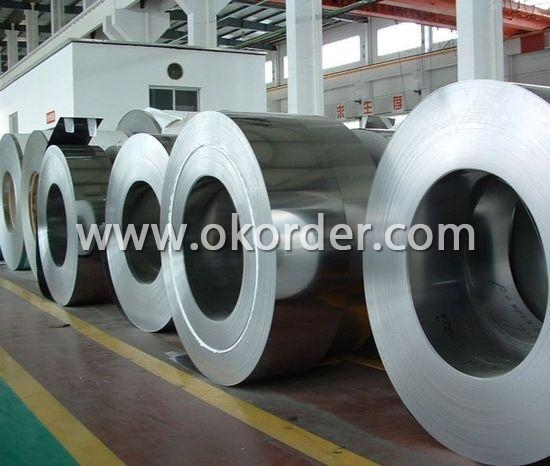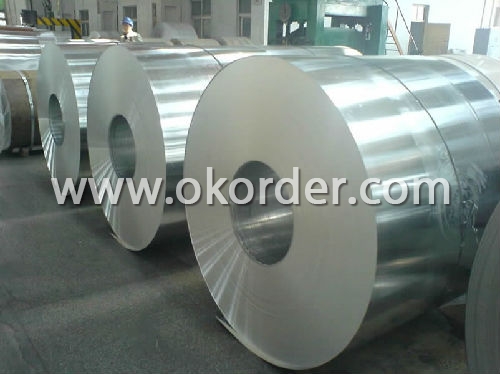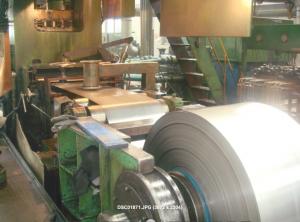201 Stainless Steel Coil / Sheet
- Loading Port:
- China Main Port
- Payment Terms:
- TT or LC
- Min Order Qty:
- 20 Ton m.t.
- Supply Capability:
- 20000 per month m.t./month
OKorder Service Pledge
OKorder Financial Service
You Might Also Like
201 Stainless Steel Coil / Sheet
1.Size of 201 Stainless Steel Coil : Thickness: 0.3mm ~~ 6mm, Width: 650mm ~~ 2100mm, Length: to be customized.
2.Material of 201 Stainless Steel Coil :SUS201,202,301,304,304L,316,316L ,321 etc.
3.Standard of 201 Stainless Steel Coil :AISI,JIS,GB,DIN
4.Finish of 201 Stainless Steel Coil :Black, No.1, 2B, 2D, BA, NO.3, NO.4, SB, NO.8, HL
5.Testing of 201 Stainless Steel Coil :Each heat number and batch must be tested for both chemical and mechanical properties
Stainless Steel Coil / Sheet | |
Standard | JIS, AISI, ASTM, GB, DIN, EN |
Property | Stainless steel coil, Stainless steel sheet, Stainless steel plate, stainless steel |
Length | 1-12m |
Quality | prime |
Manufacturing Process | factory direct sale |
Surface Treatment | Black, No.1, 2B, 2D, BA, NO.3, NO.4, SB, NO.8, HL |
Main Grade | 201,201,301,302,303,304,321,316,316L,309,310,309H, 310S,431,430,420,430F |
Model Number | 304 stainless steel channel,201 stainless steel channel |
MOQ | 20 ton |
Trade Term | FOB China mainport |
Payment term | T/T or L/C |
Price | negotiable |
Packing | Export packing |
Dilvery time | 20days or depend on order quantity |
Container | The capacity for a 20" container:20-24tons |


- Q:How do stainless steel strips perform in corrosive marine environments?
- Stainless steel strips possess a high resistance to corrosion and exhibit exceptional performance in corrosive marine settings. Their unique composition, consisting of chromium, nickel, and other alloying elements, enables the formation of a protective oxide layer on the surface. This layer acts as a barrier, effectively shielding the strips from corrosive elements like saltwater, moisture, and atmospheric conditions encountered in marine environments. The corrosion-resistant nature of stainless steel strips makes them highly suitable for various marine applications, including boat fittings, marine hardware, offshore platforms, and underwater structures. They are capable of enduring the harsh conditions of saltwater, waves, and high humidity without compromising their structural integrity or aesthetic appeal. Moreover, stainless steel strips offer excellent resistance against pitting and crevice corrosion, which are prevalent forms of corrosion in marine settings. This characteristic ensures their long-term durability and reliability, even in highly corrosive conditions. In addition, stainless steel strips are easy to clean and maintain as they do not require any additional coatings or treatments to protect against corrosion. Regular cleaning with fresh water is typically sufficient to maintain their excellent condition. In conclusion, stainless steel strips are an ideal choice for corrosive marine environments due to their exceptional resistance to corrosion, strength, and durability. They provide a cost-effective and reliable solution that can withstand the challenges posed by the marine environment, ensuring long-lasting performance.
- Q:Are 111 stainless steel strips suitable for chemical reactors?
- Yes, 111 stainless steel strips are suitable for chemical reactors. They possess excellent corrosion resistance, high temperature resistance, and good mechanical properties, making them suitable for handling various chemicals and operating conditions within a reactor.
- Q:What are the common surface defects in stainless steel strips?
- Common surface defects in stainless steel strips include scratches, pits, roll marks, and scale.
- Q:Are stainless steel strips available in different widths?
- Yes, stainless steel strips are available in different widths.
- Q:Are 111 stainless steel strips suitable for high-wear applications?
- 111 stainless steel strips are not suitable for high-wear applications. Although stainless steel is typically recognized for its corrosion resistance and durability, grade 111, which falls into the austenitic stainless steel category, exhibits lesser resistance to wear and tear when compared to grades like 304 or 316. In instances of high-wear applications where the material undergoes continuous friction, abrasion, or impact, it is recommended to utilize a stainless steel of higher grade to guarantee improved performance and longevity.
- Q:How do stainless steel strips perform in high pressure environments?
- Stainless steel strips boast exceptional performance in high-pressure environments, owing to their unique composition rich in chromium and nickel. As a result, these strips offer excellent resistance against corrosion, oxidation, and scaling, rendering them exceptionally reliable and durable even in high-pressure applications where alternative materials may falter. In environments characterized by high pressure, stainless steel strips uphold their structural integrity and dimensional stability unwaveringly. They possess the ability to withstand extreme pressure without undergoing any deformation or breakage, thereby guaranteeing system safety and efficiency. Moreover, stainless steel strips exhibit remarkable tensile strength, enabling them to endure the forces exerted by high-pressure conditions. Additionally, stainless steel strips demonstrate exceptional heat resistance, enabling them to withstand the elevated temperatures associated with high-pressure environments. They can endure thermal expansion and contraction, thereby preserving their shape and performance even amidst fluctuating temperature circumstances. In the realm of chemical resistance, stainless steel strips prove highly suitable for high-pressure environments where exposure to corrosive substances remains a concern. They exhibit remarkable resistance against acids, alkalis, and diverse chemicals, thereby preventing degradation and upholding strip performance over time. Furthermore, stainless steel strips are effortless to clean and maintain, a crucial feature in high-pressure environments where hygiene and sanitation are of utmost importance. Their non-porous nature prevents the accumulation of bacteria or other contaminants that could potentially compromise strip performance. In conclusion, stainless steel strips represent the optimal choice for high-pressure environments. Their corrosion resistance, high strength, heat resistance, and chemical resistance properties make them remarkably reliable and durable in such conditions.
- Q:What are the factors affecting the thermal conductivity of 111 stainless steel strips?
- The thermal conductivity of 111 stainless steel strips can be influenced by several factors: 1. The chemical composition plays a crucial role in determining the thermal conductivity of the stainless steel. The presence of different alloying elements can either enhance or impede the flow of heat within the material. 2. The microstructure of the stainless steel, including the size, distribution, and shape of its grains, also affects its thermal conductivity. A more uniform and fine-grained microstructure generally results in higher thermal conductivity. 3. Temperature is another variable that impacts the thermal conductivity of stainless steel. As the temperature increases, the thermal conductivity tends to decrease due to increased lattice vibrations and phonon scattering, which hinder heat flow. 4. The heat treatment process used during the production of stainless steel strips can have an impact on their thermal conductivity. Specific heat treatments, such as annealing or quenching, can modify the microstructure and therefore affect thermal conductivity. 5. The addition of certain alloying elements, such as nickel or copper, can enhance the thermal conductivity of stainless steel. These elements can improve the mobility of electrons or phonons, resulting in better heat conduction. 6. The surface finish of stainless steel strips also plays a role in their thermal conductivity. A smooth surface with minimal imperfections or roughness allows for better thermal contact and heat transfer. 7. The thickness of stainless steel strips can influence their thermal conductivity as well. Thinner strips typically have higher thermal conductivity due to shorter heat transfer paths. 8. The presence of impurities or defects in the stainless steel, such as inclusions or voids, can hinder the flow of heat and reduce thermal conductivity. Considering these factors is crucial when selecting and utilizing stainless steel strips for applications that require efficient heat transfer.
- Q:Are stainless steel strips magnetic?
- Yes, stainless steel strips can be magnetic or non-magnetic, depending on the specific type of stainless steel used. Stainless steel is an alloy that contains iron, which is inherently magnetic. However, the addition of certain elements such as nickel or manganese can alter the magnetic properties of stainless steel. Stainless steel strips that have a higher nickel content, such as the popular 304 or 316 grades, are generally non-magnetic. On the other hand, stainless steel strips with lower nickel content, such as the 400 series, can be magnetic. Therefore, it is important to consider the specific grade and composition of the stainless steel strip when determining its magnetic properties.
- Q:What is the maximum temperature stainless steel strips can withstand?
- The maximum temperature that stainless steel strips can withstand depends on the specific grade of stainless steel being used. Generally, stainless steel is known for its high heat resistance and can withstand temperatures up to 1450°C (2642°F) without significant structural changes or loss of mechanical properties. However, it's important to note that prolonged exposure to high temperatures can lead to oxidation and scaling on the surface of stainless steel, which may affect its performance. Additionally, different grades of stainless steel have varying levels of heat resistance, so it is crucial to consult the manufacturer's specifications or a materials engineer for accurate information on the maximum temperature tolerance of specific stainless steel strips.
- Q:How do you store stainless steel strips?
- To store stainless steel strips properly, it is important to take certain precautions to prevent damage and maintain their quality. Here are some recommended steps to follow: 1. Clean and dry: Before storing stainless steel strips, make sure they are thoroughly cleaned and dried to remove any dirt, dust, or moisture. This will prevent corrosion or staining during storage. 2. Protect from moisture: Stainless steel is susceptible to rust, so it is crucial to keep the strips away from moisture. Store them in a dry and well-ventilated area, away from any water sources or high humidity environments. 3. Avoid contact with other metals: To prevent potential galvanic corrosion, avoid storing stainless steel strips in direct contact with other metals, especially those that are less noble or prone to corrosion. If stacking the strips, consider using separators or protective layers made of plastic or non-reactive materials to prevent direct metal-to-metal contact. 4. Use proper packaging: To provide additional protection, consider packaging the stainless steel strips in appropriate materials such as plastic wrap, paper, or specially designed corrosion-resistant packaging. This will help prevent scratches, corrosion, or other damage during storage or transportation. 5. Organize and label: Properly organize and label the stainless steel strips to easily identify and retrieve them when needed. This will help prevent unnecessary handling and potential damage caused by searching or mishandling. 6. Temperature control: While not always feasible, maintaining a controlled temperature can help prolong the lifespan of stainless steel strips. Extreme temperature variations can cause expansion and contraction, leading to stress and potential deformation. If possible, store the strips in a temperature-controlled environment. By following these guidelines, you can ensure that your stainless steel strips remain in excellent condition and ready for use whenever needed.
1. Manufacturer Overview |
|
|---|---|
| Location | Hebei,China |
| Year Established | 1989 |
| Annual Output Value | Above US$160 Thousand |
| Main Markets | Europe, East Asia and Southeast Asia |
| Company Certifications | ISO9001:2000; |
2. Manufacturer Certificates |
|
|---|---|
| a) Certification Name | |
| Range | |
| Reference | |
| Validity Period | |
3. Manufacturer Capability |
|
|---|---|
| a)Trade Capacity | |
| Nearest Port | Tianjin |
| Export Percentage | 70% |
| No.of Employees in Trade Department | 30 People |
| Language Spoken: | English;Chinese |
| b)Factory Information | |
| Factory Size: | Above 14,500 square meters |
| No. of Production Lines | Above 6 |
| Contract Manufacturing | OEM Service Offered;Design Service Offered |
| Product Price Range | Average |
Send your message to us
201 Stainless Steel Coil / Sheet
- Loading Port:
- China Main Port
- Payment Terms:
- TT or LC
- Min Order Qty:
- 20 Ton m.t.
- Supply Capability:
- 20000 per month m.t./month
OKorder Service Pledge
OKorder Financial Service
Similar products
New products
Hot products
Hot Searches
Related keywords



























